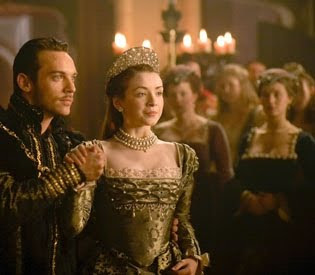Spring Break was a few weeks ago and while away from school I was able to catch up on some television. My favorite show, Psych, is off for the summer so I've been updating the world of the Tudors on Netflix. This might surprise one or two of you, since the show is not necessarily made-for-family viewing. But much like the period dramas that have made their way to cable television, I think it is as realistic a depiction of life in 16th century England as allowed. (Season 4 trailer is here: http://www.youtube.com/watch?v=sawkFsNSrAk)
I've always been fascinated with English history. I don't know why. Perhaps the old stories and myths and magic that seems to permeate through the textbooks of my junior high years. I can recall in 6th grade a women, probably slightly older than I am now, coming to speak to our class who studied medieval England. I thought she was so cool! I don't think I ever told anyone that. And to know now, that I am distantly related to a queen of Henry VIII, his most loved 3rd wife, Jane, makes me all the more curious about life then.
As I've watched the show, I've become intrigued by the figure of Mary, Henry's oldest daughter, known to us now as Bloody Mary. She was devoutly Catholic, something remarkable considering her father broke England from the Catholic church and founded Anglicanism. She could not have lived a happy life, being turned against once King Henry VIII divorced her mother, the great daughter of Spain's Isabella & Ferdinand. Following this move, Henry made her illegitimate, demoting her from princess to lady. This followed the birth of a half-sister, Elizabeth, to be revered through the ages as the Great Virgin Queen, born of a woman who tried to have Mary put to death. Mary's father went on to marry 4 more women, two of which helped reconcile the father with daughter, to the extent it was possible.
What makes Mary's story more poignant to me is that here is a girl, whose own father was marrying women younger than she was at a time when women married in their early teens. The threat of being a bastard of a kind prevented her marriage. The fact that she was Catholic caused Henry VIII to avoid marrying her, in case the pro-Catholic factions in turbulent England decided to rise again. And Mary wouldn't think of marrying a Protestant. Yet through all of this, Mary's greatest desire was to have children and be married. When her young brother, Edward VI, was born, Mary was 21. She treated him like the child she was destined to never have.
Yet when little brother, King Edward, died Mary took over the throne, the final gift her father had bestowed onto her should his longed for heir pass away. She married at age 37, well past the age of the women of her time, to her cousin, Philip of Spain. She would die just 5 years later, childless and ill-remembered. Out-shined by half-sister, Elizabeth.
Despite Mary's futile efforts to turn England back into a Catholic nation (Bloody Mary comes from her attempts to destroy the Protestant leaders in England from her father and brother's reigns), her story can lend a bit of hope, if you just look for it. This is a woman who persevered through threats of death, desertion, isolation and separation from family to achieve the marriage of her dreams at age 37 and goal she had always fought for - her rightful place as the eldest child of Henry VIII on the throne of England.
If you can put in perspective that Mary was not the only monarch of the period to put hundreds if not thousands of people to death for their religious beliefs and focus on the humanistic side for a moment, you would see that circumstance created the person she was to become. Elizabeth, too, suffered similar threats and abandonment, but not to the extent of her older sibling, especially because Elizabeth was staunchly Protestant. Mary was there through all 6 of her fathers' wives and was the only member of the family to stay Catholic. I can't imagine what Mary went through but I can learn from her perseverance in holding out for love.
If you can put in perspective that Mary was not the only monarch of the period to put hundreds if not thousands of people to death for their religious beliefs and focus on the humanistic side for a moment, you would see that circumstance created the person she was to become. Elizabeth, too, suffered similar threats and abandonment, but not to the extent of her older sibling, especially because Elizabeth was staunchly Protestant. Mary was there through all 6 of her fathers' wives and was the only member of the family to stay Catholic. I can't imagine what Mary went through but I can learn from her perseverance in holding out for love.
I hope you enjoyed the history lesson. And in case you are curious, Jane Seymour's mother was Margaret Wentworth, a cousin of my ancestor who immigrated to the USA in the 1600's. Who knows what I'll write about next!

No comments:
Post a Comment